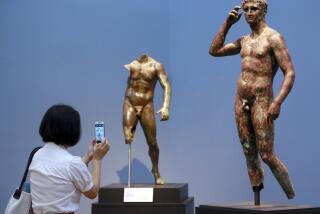‘Three Graces’ Saga: Getty Purchase Delayed Again : Art: The latest action by Britain to defer an export license is just one of many setbacks in the museum’s five-year effort to buy the Antonio Canova statue.
- Share via
The J. Paul Getty Museum’s five-year attempt to buy Antonio Canova’s neo-classical sculpture “The Three Graces” for $12.3 million and export it from England has been stalled once again. In February, the British Department of National Heritage deferred the Getty’s export license until Aug. 5, but now the deferral has been extended for three more months.
The ongoing saga pits cultural aspirations of British authorities, who fear losing their artistic heritage, against the ambitions of a wealthy American museum.
The delay, announced Tuesday by British National Heritage Secretary Stephen Dorrell, allows London’s Victoria and Albert Museum additional time to match the Getty’s price and keep the marble statue in England. To date, the V&A; has raised 4.7 million ($7.6 million) toward the purchase. The museum is exploring a partnership with the National Galleries of Scotland that would contribute an additional 1.1 million ($1.8 million) leaving a balance of 1.8 million ($2.9 million) to be raised by Nov. 5.
The Getty museum, which first tried to purchase the artwork in 1989, expressed disappointment at the decision to delay shipping it.
In a statement to the press Tuesday morning, Getty director John Walsh said: “Evidently the faith we have had in the fairness of the British export license system has been misplaced.
“The British government refused to acquire the statue for 1.2 million in 1983. No British or Scottish museum has made an offer for the statue over the intervening 11 years, for most of which the statue has been in storage.
“On two occasions that we have endeavored to purchase the statue, our efforts have been blatantly frustrated by manipulations of the export license system, this time with the launch of a public appeal for funds announced after the deferral period had expired.
“We know that our disappointment will be shared by many museum colleagues internationally. We also happen to believe that the decision to defer, yet again, the grant of an export license will have a significant effect on London’s position in the international art market,” the statement said.
In England, where the Canova affair has been something of a media event, the extension was greeted with relief. V&A; Director Elizabeth Esteve-Coll issued a statement, saying: “We welcome the decision by Stephen Dorrell as a recognition of our commitment to our cultural heritage. As the home of the National Collection of Sculpture, the V&A; recognizes the immense significance of this statue and has made every possible attempt to raise the funds needed to save it for the nation.”
*
The marble statue depicts the nude daughters of Jove--Aglaia (Grace), Athalia (Beauty) and Euphronsyne (Joy). For the Getty, it is a union of the classical and the 19th-Century periods, two important areas in the museum’s collection. “In a single statue, it sums up a lot of ideals of the neo-classical period. Not the heroic ideals, but ideals of feminine beauty and harmony,” Walsh said by phone Tuesday.
The sculpture was commissioned in 1814 by John Russell, 6th Duke of Bedford, and installed in 1819 in the newly built Temple of the Graces at Woburn Abbey in Bedfordshire. The Marquess of Tavistock, owner of Woburn Abbey, sold the work in 1984 to Fine Art Investment and Display Ltd., a Cayman Islands company.
The Getty agreed to buy the Canova in 1989, but the British Reviewing Committee on the Export of Works of Art recommended that an export license be deferred for six months so that a British museum could match the Getty’s price. The V&A; in 1990 launched a public appeal for funds to buy the statue and put it on display for six months. The museum raised a mere 70,000 ($113,400) during that period, but a series of delays has thwarted the Getty’s attempts to follow through on its offer while the V&A; has slowly built up its war chest.
Though Secretary Dorrell said the sculpture “has a place at the heart of our national heritage,” he said he would not extend the deadline past three months.
Muchnic reported from Los Angeles and Tuohy from London.
More to Read
The biggest entertainment stories
Get our big stories about Hollywood, film, television, music, arts, culture and more right in your inbox as soon as they publish.
You may occasionally receive promotional content from the Los Angeles Times.










